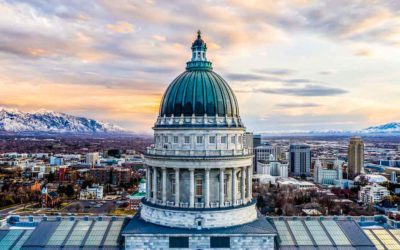
Written by Rick B. Larsen
August 5, 2021
The controversy around critical race theory (CRT) in Utah classrooms has reached a new level of division. First, some voices are suggesting, wrongly, that their controversial reactions to CRT represent unified partisan views. Other voices are telling us that limiting freedom – in the name of freedom – is a justified means to an end in opposing CRT.
Fueled by justifiable concern – but also fear and misinformation – the reaction to CRT now includes a proposed ban on a specific list of words and concepts.
A debate of this magnitude, and of such consequence in the long term, calls for a more disciplined and principled approach. It demands that we as a state apply the lessons of history, civics, and the principles of freedom – the very things we desperately need more of in the classroom. It requires a comprehensive solution that will not be achieved through government policing of lists of unspeakable words.
A list of banned words and ideas in the public classroom is a reaction – not a solution.
The CRT debate includes many groups. Among them are activists with agendas – some opposed to CRT, some in favor. But also among them are voices that deserve to be heard: parents seeking to protect their children from ideas they see as not age-appropriate and therefore damaging, and communities of color who have been omitted from education about American history. We cannot surrender this critical moment to the activists, nor can we continue to react rather than solve.
Most CRT debates still lack clarity as to what precisely CRT is and what it purports to accomplish. Accuracy demands that we cite the practitioners of the concept. Fairness demands that we recognize that not all parties using the term intend the same meaning.
In the words of critical race theorists – or “progressive race scholars,” as they sometimes refer to themselves – critical race theory is both an “intellectual movement” and a “political position from which to criticize the racial status quo,” adhered to by “a collection of activists and scholars” who are “dedicated to the production of politically engaged scholarship” that “questions the very foundations of the liberal order,” such as merit or rights, “with the hope of dismantling systems that subordinate people of color.”
For parents wondering if CRT (not to be confused or conflated with the desire for a more accurate study of race in America) is progressive, political and activist in tone – the words of its practitioners say that yes, it is. It is for these reasons CRT should not be featured in K-12 civics and history curriculum.
For communities of color seeking to be included in public school lessons about history and represented with fairness and accuracy (and asking for their own priorities to be reflected in public schools), CRT – as it is defined above – is not a constructive approach.
As Sutherland Institute’s Derek Monson recently wrote, “CRT bans have some merits. As one policy thinker put it, ‘These laws will undoubtedly curb some of the most insidious messages bombarding our kids.’ But bans are ‘ultimately only a partial bandage’ because they can be evaded by smart curriculum providers – meaning that a ban may prove ineffective at accomplishing its goal.”
American Enterprise Institute scholar Rick Hess goes further, stating that CRT bans may make it more difficult over time to create a real solution. He adds that “extensive lists of legally banned ideas erode the American principle of valuing the marketplace of ideas.”
If our true goal is to maintain the freedom inherent in a free marketplace of ideas and educate future citizens who understand the principles and predicates of freedom, we must not – no matter the underlying motivation – aim to ban ideas and restrict thought. And if we choose to do that as a step, we are not pursuing a solution.
If the goal is to end, in Hess’s words, “dangerous, discriminatory pedagogical practices” in the classroom, we must replace those emerging practices with intentionally created content, standards and training.
According to Hess, “the first approach (banning) is destructive, wrong-headed, and obscures the common ground that is there to be found; the second (ending harmful pedagogy) is appropriate, even essential” (emphasis added).
We should all keep in mind Monson’s reasoning that “the more extensive bans become, the more commonplace becomes the banning of ideas that fall out of favor for political reasons. And because political pendulums always swing back and forth – even in a red state like Utah, the pendulum will swing from more moderate to more conservative and back again – this means that ideas that are considered fine today can become ban-worthy next year or in a few years from now.”
Bans and word lists create a never-ending cycle of curriculum politicization. It shifts the focus to what is being taught in the classroom and how it is being taught, rather than accomplishing the real goal of depoliticizing the classroom and educating our children.
But if not a ban, then what? Sutherland Institute has recommended a three-part solution to depoliticize the classroom: (1) empower parents by improving curriculum transparency with a public school syllabus for every grade level, (2) reduce classroom controversy by giving students and families the ability and means to pursue the curriculum and learning path that fits them best by expanding education choice, and (3) resume a necessary function of public education – providing students with a functional understanding of American civics and history – by reforming curriculum at the local level, standards at the state level, and teacher training at all levels, to restore a rigorous and sequenced civics and history education in every public school classroom.
The American constitutional system requires consensus-building compromise as the mechanism for securing the vision of equality and liberty articulated in the Declaration of Independence and the rights and freedoms secured in the U.S. Constitution and Bill of Rights. These unique constructs of freedom sought to avoid and overcome such “no-compromise perpetual political wars” that have plagued history – and vex us today.
Since the post-WWII era, civics and history curricula have been in decline. The reasons are many, but the simple explanation is that public education shifted from the goal of educating citizens to the goal of educating for employment and, later, for high-stakes testing in subject areas other than history and civics. With those changes in priority came shifts in how classroom time was allocated. Citizenship and freedom – as academic studies – have since dwindled to a dangerous level.
In this moment, Utah has an opportunity to recognize the rights and concerns of parents alongside those of marginalized communities calling for more representation in history curriculum. We can best achieve that by keeping truth – not ideology – at the center of the process; by making accuracy and context the guardrails. Let’s choose a course that – as history teaches us – will expand freedom rather than limit it.
More Insights
Read More
Is California’s minimum wage hike a mistake?
Is raising the minimum wage a good tool to help low-income workers achieve upward mobility? That’s the key question at the heart of the debate over California’s new $20 an hour minimum wage law for fast food workers.
Why is Utah at odds with Justice Department over treatment of gender-dysphoric prisoner?
Lawsuit illustrates a little-known practice of federal agencies – giving various forms of “guidance” which are not supposed to be legally binding. The practice raises serious legal and constitutional questions.
What would a parent-teacher ‘handshake’ look like in Utah?
This partnership does not allow either party to pass blame entirely to the other. There is no scapegoat, only opportunities for either party or both to work on the factors within their scope.


